
ANDYBROUWER.CO.UK
CAMBODIA TALES 2003
Preah Khan in a mess
A 6.30am departure by share-taxi from Siem Reap, a short stop at Kompong Kdei and we reached Kompong Thom in three hours. Sokhom was there to meet me as we'd arranged and we called into the Arunras restaurant for a late breakfast before packing our overnight bags for a 5-day trip into the far north. I had to twist Sokhom's arm a little as the trip was a long one but he could see I was keen, so we set out on his trusty Daelim moto at 11.30am to get to Tbeng Meanchey (TBM) before dusk. The road north was unusually busy, and dusty, with trucks and 4WD's returning from a ceremony at Preah Vihear. Sokhom has been told that 1,000 people from Phnom Penh had made the trip to celebrate the re-opening of the temple and the new road and soldiers had been placed at every bridge along the route. Certainly CMAC deminers were in evidence along part of the road before we reached Phnom Dek after two hours, stopping for petrol, ice-cold water and some sugar cane drinks. During an equipment check, I found my main camera wasn't working so we pressed ahead with fingers crossed that my back-up camera would withstand the bumpy ride. We reached TBM five hours after leaving Kompong Thom and it was noticeably busier than on my last visit. I soon found out why when we tried to get a room for the night. The Phnom Meas and Prum Tep guesthouses were full and the Mlob Trosek had one room left. The hordes from Phnom Penh had taken all available rooms bar one, which we snapped up. As the sun began to set we went to the river and then a nearby lake to try out my substitute camera, which I always carry with me but hadn't needed to use for at least two years. At the Malop Dong restaurant, the rush of visitors had exhausted supplies of chicken, so I settled for beef and vegetables instead and some voracious mozzies settled for me, as I received half a dozen bites despite my deet spray and an overhead fan. As we drove past the Phnom Meas, I spied Gordon Sharpless and Paul Hay and we joined them at the Dara Reas restaurant for food and then at Kove's tikalok stall for late-night fruit smoothies. Gordon and Paul, who runs Hidden Cambodia dirtbike tours, had been to Preah Vihear to watch the celebrations and estimated the crowd at 5,000 people. Kove was as lovely as ever and still quite shy, though she'd received a proposal of marriage from a Phnom Penh-based foreigner the week before and her stall was bursting at the seams with customers. We eventually said our goodbyes and returned to our guesthouse at 11.30pm for an interupted night's sleep.
A cold shower before breakfast at the Malop Dong and we were on our way by 8am, taking the road north towards Preah Vihear. Our destination was actually the town of Choam Khsan and a temple-hunting expedition for Prasat Preah Neak Buos, a large temple site in its heyday but had it survived the ravages of time and the Cambodian civil war? That was to be our quest. It took an hour to reach the massive Takeng bridge and after that the road, though widened since my previous trip north, was as lonely and desolate as before. No people, no vehicles, just trees and shrub, a few patches of burnt and smouldering undergrowth and a track that alternated between hard mud and soft sand. After 2½ hours we reached the junction that heralded the right-hand turn off to Choam Khsan, some 35kms away. It came as a shock that the first people we saw for two hours were a unit of Army sappers sweeping the main road with mine-detectors, but they waved us through and we began a real struggle along the narrow track, which was deep sand and it felt like I walked more than I sat on the moto. At one stage I hitched a lift on a passing oxcart for 100 metres, much to the delight of the family already on it. A priceless moment. We arrived at the town of Choam Khsan at mid-day and it was completely devoid of people, apart from a foodstall along the main street, where we sat down for a pork and rice meal. I say main street, at noon it was empty and only livened up later in the afternoon. We called into the Heng Heng guesthouse, opposite the market, to book one of their stuffy, wooden cubicles with a large bed that Sokhom and I had to share.
Talking to the guesthouse owner, he went and checked with the commune chief that we could visit Prasat Neak Buos but it would have to be the next day as Soveat, who'd guide us there, wasn't around. After a rest, Sokhom and I drove slowly around the town, which was well spread out and perfectly rural with rice-threshing, silk-weaving and buffalo-washing taking place with the inhabitants far outnumbered by pigs, buffalo, chickens and dogs. Stopping off at Wat Tuol Dan, with wall paintings inside and outside the main wooden vihara, we met up with a member of the Council of Ministers, HE Yim Samnang and his entourage, who were visiting his grandfather, the head monk at the pagoda. Our next stop was at the election registration post, where loud-hailers were inviting the local populace (I was told 10,000 people) to come and register to vote at the forthcoming elections, and we stopped nearby for fresh coconuts and papaya. Back at the guesthouse, I played tot-sey (foot shuttlecock) with Osman and Ahmad, two Muslims who'd come to town to buy a couple of buffalo, before a cold shower and a return to our foodstall at 6.30pm. On the menu was pork, cabbage and catfish, under candlelight until they hooked up a battery and a lightbulb, that soon attracted every flying insect in the vicinity. Amid the usual scenes of rural domesticity, and with no tikalok stand to try out, we walked back to our room where the generator was working and under a dim red lightbulb in our cubicle, I could see our mozzie net was more a series of holes than net! Having received bites into double figures the night before, I spent the next hour mending the net with bits of string. Though the generator thudded to a halt at 8pm, the loud-speaker system maintained its barrage of encouragement to the locals to make best use of the harvest and to vote at the elections, and it was still going strong when I woke intermittently at 11pm, 2am and 4am.
The next day dawned with Prasat Neak Buos as our target. Read about our adventure here. We'd only managed to scratch the surface of this temple site and I hope to return one day to take a closer look and to see what else lies in wait nearby. Back at the guesthouse, I had a late afternoon shower and returned to the town's only foodstall for pork and catfish with the owners Savoeun and his wife Mom, who'd lived in the town for a decade but were worried that the new road to Preah Vihear would mean Choam Khsan would become a backwater. Under a full moon, we walked back to the guesthouse and were in bed by 7.30pm. It was surprisingly cold and a 'tok-ke' lizard and a dawn chorus of roosters tried their best to interupt my sleep. We were up and out and on the road by 6am, it was still dark but had warmed up an hour later, as we bypassed some of the deminers on the road to Preah Vihear. We reached the T-junction at 7.30am and retraced our steps back to Tbeng Meanchey, arriving some four hours after leaving Choam Khsan. My back and bum ached from the hard, bumpy ride as Sokhom had driven back as quickly as he could. We called into the Malop Dong for a chicken and rice breakfast, said our goodbyes to Kove as we filled up with petrol and left at 10.30am.
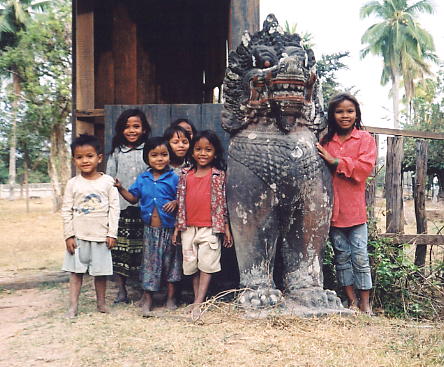 Our new destination was
Preah Khan of Kompong Svay, a massive temple site that I had yet
to visit. Returning along the road to Kompong Thom, there are two
ways to visit Preah Khan and we passed the first 1½ hours into
our journey, just before a series of bush-fires along the road
heated up the day noticeably. Sokhom prefers a different route to
the temple, so we pushed onto Phnom Dek, which we reached at 1pm.
Half an hour later, refreshed and fed, we took a narrow track
west of the village into the countryside and away from
civilisation. Crossing dried riverbeds, I lost count after half a
dozen, devoid of homes and people but popular with those
bush-fire arsonists, we finally encountered our first sign of
human life two hours into our trip, when we stumbled upon a
family of eight eating their lunch, who were more shocked to see
us than we were them. Their riverbed picnic was the last river
before the village of Ta Seng, some six kilometres away, and a
major obstacle if visiting the temple site in the wet season
Sokhom informed me. We arrived at Ta Seng, two kilometres from
the Preah Khan temple site, at 3.45pm and pulled
Our new destination was
Preah Khan of Kompong Svay, a massive temple site that I had yet
to visit. Returning along the road to Kompong Thom, there are two
ways to visit Preah Khan and we passed the first 1½ hours into
our journey, just before a series of bush-fires along the road
heated up the day noticeably. Sokhom prefers a different route to
the temple, so we pushed onto Phnom Dek, which we reached at 1pm.
Half an hour later, refreshed and fed, we took a narrow track
west of the village into the countryside and away from
civilisation. Crossing dried riverbeds, I lost count after half a
dozen, devoid of homes and people but popular with those
bush-fire arsonists, we finally encountered our first sign of
human life two hours into our trip, when we stumbled upon a
family of eight eating their lunch, who were more shocked to see
us than we were them. Their riverbed picnic was the last river
before the village of Ta Seng, some six kilometres away, and a
major obstacle if visiting the temple site in the wet season
Sokhom informed me. We arrived at Ta Seng, two kilometres from
the Preah Khan temple site, at 3.45pm and pulled 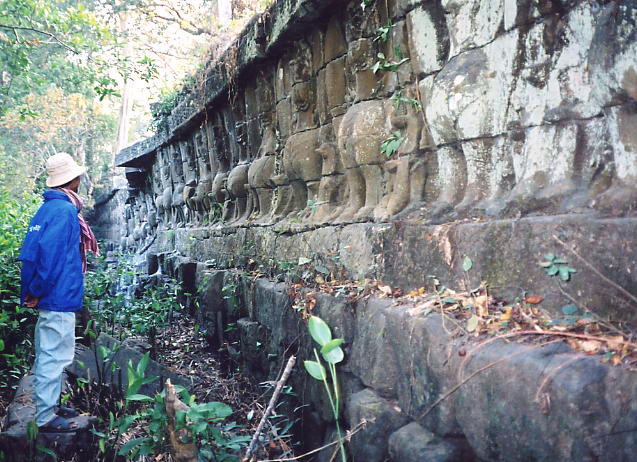 into the home of Ket
and Ouk, his wife, where we'd spend the night. Sokhom knew the
family well and the yard in front of their wooden home on stilts,
soon filled up as news of my arrival filtered out to the children
in the village. With hello and goodbye in the same sentence, we
carried onto one of the satellite temples, Prasat Preah Damrei,
just ten minutes ride away. Sitting on a small rise next to a
large water-filled baray, the temple is a stepped pyramid
dedicated to its collection of stone elephants, two remain intact
and both are adorned with robes, alongside four beheaded lions,
entrance gates with female devatas carved into niches and a naga
head in good condition with garudas at its northern entry point.
The whole Preah Khan complex of temples - which is known locally
as Prasat Bakan - was constructed by King Jayavarman VII around
the 12th century and is the largest single complex amongst the
whole series of Angkorean temples. It was a relaxing end to a day
spent on Sokhom's moto - nearly ten hours, no less - to be able
to clamber over the ruins at a leisurely pace in such an
attractive setting.
into the home of Ket
and Ouk, his wife, where we'd spend the night. Sokhom knew the
family well and the yard in front of their wooden home on stilts,
soon filled up as news of my arrival filtered out to the children
in the village. With hello and goodbye in the same sentence, we
carried onto one of the satellite temples, Prasat Preah Damrei,
just ten minutes ride away. Sitting on a small rise next to a
large water-filled baray, the temple is a stepped pyramid
dedicated to its collection of stone elephants, two remain intact
and both are adorned with robes, alongside four beheaded lions,
entrance gates with female devatas carved into niches and a naga
head in good condition with garudas at its northern entry point.
The whole Preah Khan complex of temples - which is known locally
as Prasat Bakan - was constructed by King Jayavarman VII around
the 12th century and is the largest single complex amongst the
whole series of Angkorean temples. It was a relaxing end to a day
spent on Sokhom's moto - nearly ten hours, no less - to be able
to clamber over the ruins at a leisurely pace in such an
attractive setting.
We returned to the village and
called at a well-stocked stall for some overnight provisions
before joining the locals at the village water-pump for a shower,
wrapped only in my krama to cover my modesty. Very quickly an
audience appeared, mostly women and children, and in the fading
light I did my best to ladle water over my 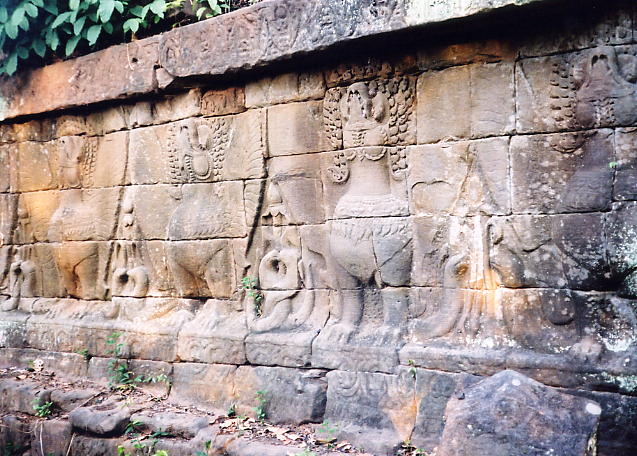 head with one hand and
hang onto my krama with the other. Everyone found it highly
amusing, the crowd of youngsters in particular. Back at Ket's
house, the family gave up their bed despite my protests, found a
mozzie net and a cushion and killed and cooked a chicken for our
evening meal, under candlelight. The soup that Ouk produced was
delicious with large chunks of chicken, rather surprising as the
chicken that Ket had shown me before he wrung its neck had looked
incredibly scrawny. By 7.30pm everyone settled down for the
night. Ket, Ouk, their six children and grandma in a corner near
the stove, Sokhom in his hammock and yours truly lying on a hard
wooden bed. I awoke at various times during the night mainly
because it was very cold, but also due to a variety of animal
noises under the house and as one of the children had a
persistent cough.
head with one hand and
hang onto my krama with the other. Everyone found it highly
amusing, the crowd of youngsters in particular. Back at Ket's
house, the family gave up their bed despite my protests, found a
mozzie net and a cushion and killed and cooked a chicken for our
evening meal, under candlelight. The soup that Ouk produced was
delicious with large chunks of chicken, rather surprising as the
chicken that Ket had shown me before he wrung its neck had looked
incredibly scrawny. By 7.30pm everyone settled down for the
night. Ket, Ouk, their six children and grandma in a corner near
the stove, Sokhom in his hammock and yours truly lying on a hard
wooden bed. I awoke at various times during the night mainly
because it was very cold, but also due to a variety of animal
noises under the house and as one of the children had a
persistent cough.
Sokhom and I set off just
before 7am the next day to spend a good portion of the morning at
the temple site. It took us ten minutes to negotiate the sandy
track, before we arrived at the eastern entrance to the main
temple of Preah Khan, which has a processional bridge with
garudas and hamsas holding up the causeway, leading to an
imposing sandstone gateway gopura. Through the entrance, on
either side were two structures called 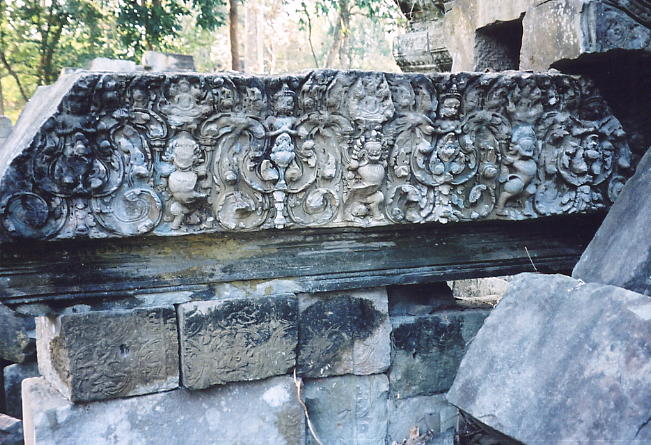 Prasat Bonteay, a
sandstone library, and Prasat Kakdei, a laterite dharmasala
rest-house with a doorway inscription. It was here that we met
Vanna and Paon, two conservation officials and an older guy by
the name of Sotha, and they acted as our guides as we scrambled
through and over a series of ruined structures along a pathway
that Sotha knew very well. They explained that robbers had
removed much of the temple's carvings and statues in 1997 when
the site had been under Army control though other thieves had
been back chipping out heads and devatas as recently as the past
few months. Sotha showed us where the wholesale looting of some
of the towers and galleries had
Prasat Bonteay, a
sandstone library, and Prasat Kakdei, a laterite dharmasala
rest-house with a doorway inscription. It was here that we met
Vanna and Paon, two conservation officials and an older guy by
the name of Sotha, and they acted as our guides as we scrambled
through and over a series of ruined structures along a pathway
that Sotha knew very well. They explained that robbers had
removed much of the temple's carvings and statues in 1997 when
the site had been under Army control though other thieves had
been back chipping out heads and devatas as recently as the past
few months. Sotha showed us where the wholesale looting of some
of the towers and galleries had  caused them to collapse
into a jumbled mess and it was very painful to see the rampant
devastation. Once you see destruction on this level, you realise
how fortunate we are to be able to visit the temples at Angkor,
which are in pristine condition by comparison. A few of the
sandstone towers remain standing and the north and west gateways
still provide a glimpse of the monumental size it once was, but
the destruction is evident throughout and very few of the wall
carvings remain unscathed, though I did locate a couple of
lintels that were intact. Near the northern gate, Vanna recovered
a small buddha head from the undergrowth, next to the torso of a
massive male statue, but it was a rare find amongst the ruins. It
had taken us 1½ hours to navigate our way around the temple,
avoiding the red ants where possible, stepping gingerly on top of
the ruined galleries, across a raised causeway, past a series of
royal pools with garuda carvings, and I thanked Sotha for his
help with a small token.
caused them to collapse
into a jumbled mess and it was very painful to see the rampant
devastation. Once you see destruction on this level, you realise
how fortunate we are to be able to visit the temples at Angkor,
which are in pristine condition by comparison. A few of the
sandstone towers remain standing and the north and west gateways
still provide a glimpse of the monumental size it once was, but
the destruction is evident throughout and very few of the wall
carvings remain unscathed, though I did locate a couple of
lintels that were intact. Near the northern gate, Vanna recovered
a small buddha head from the undergrowth, next to the torso of a
massive male statue, but it was a rare find amongst the ruins. It
had taken us 1½ hours to navigate our way around the temple,
avoiding the red ants where possible, stepping gingerly on top of
the ruined galleries, across a raised causeway, past a series of
royal pools with garuda carvings, and I thanked Sotha for his
help with a small token.
A short moto ride brought us
to the wall surrounding Prasat Preah Stung, which with its giant
Jayavarman VII faces on the central tower offers an insight into
past glories but most of the removable carvings have 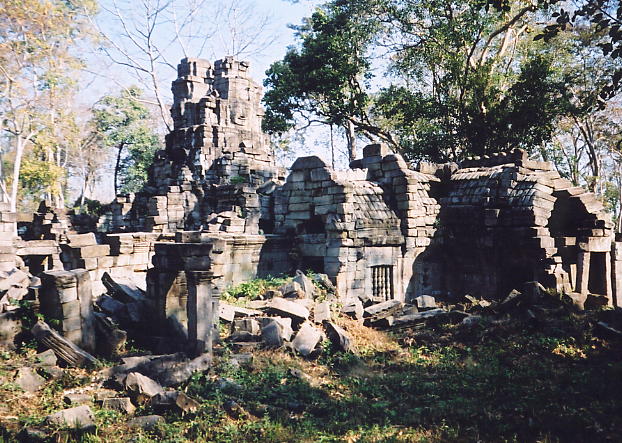 disappeared and the
base of the temple is a tangled mess. The landing stage of the
large eastern baray has similar garuda and hamsa carvings that we
found at the eastern entrance, whilst nearby, Preah Ang Thom used
to be a massive standing sandstone buddha though only the bottom
half and a hand still remain in place. Our final stop, with just
Paon on board for company, was at Prasat Preah Thkol, also known
as Mebon, located in the centre of the baray and inaccessible
during the rainy season. At this time of year, we drove through
fields and shrub to reach the sandstone temple which houses giant
garuda and elephant carvings on the sides of the central tower,
though once again, the temple had suffered badly at the hands of
the temple robbers and was in disrepair. We thanked Paon and gave
him a gift for his time, as he trudged back towards the main
complex. With only two or three tourists a month visiting Preah
Khan, usually by dirt-bike or helicopter, he was well pleased
with the extra couple of dollars. We left the complex at 10am, to
return to Ket's
disappeared and the
base of the temple is a tangled mess. The landing stage of the
large eastern baray has similar garuda and hamsa carvings that we
found at the eastern entrance, whilst nearby, Preah Ang Thom used
to be a massive standing sandstone buddha though only the bottom
half and a hand still remain in place. Our final stop, with just
Paon on board for company, was at Prasat Preah Thkol, also known
as Mebon, located in the centre of the baray and inaccessible
during the rainy season. At this time of year, we drove through
fields and shrub to reach the sandstone temple which houses giant
garuda and elephant carvings on the sides of the central tower,
though once again, the temple had suffered badly at the hands of
the temple robbers and was in disrepair. We thanked Paon and gave
him a gift for his time, as he trudged back towards the main
complex. With only two or three tourists a month visiting Preah
Khan, usually by dirt-bike or helicopter, he was well pleased
with the extra couple of dollars. We left the complex at 10am, to
return to Ket's 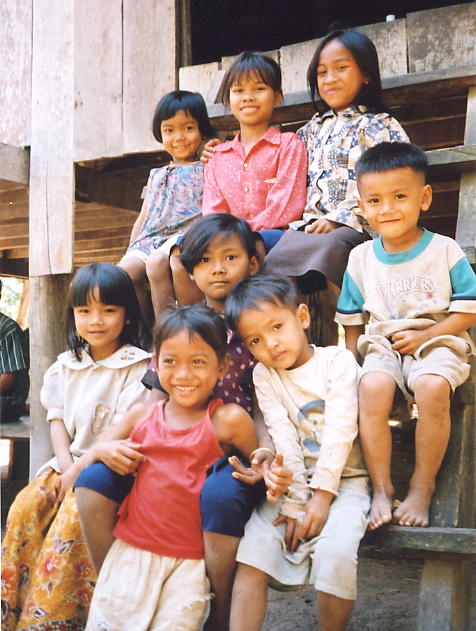 house for a chicken
and rice breakfast, and to spend some time with his playful
children. At the entrance to the nearby pagoda, two immaculate
stone lions stand guard and were removed from the Preah Khan site
a few years before for safekeeping, as we said our goodbyes to
Ket and his family and left Ta Seng for the last time, at 11am.
It took us two hours to negotiate the wilderness back to Phnom
Dek, where we enjoyed a coconut and palm juice break, and I was
well pleased to arrive back at Sokhom's house in Kompong Thom by
4pm. The road from Phnom Dek was extremely dusty and bumpy and
the dust kicked up by passing trucks and cars made the last leg
of the journey pretty unpleasant. I booked into the Mittapheap
hotel next to the river, spent a long time under the hot shower
washing off the dust and grime and had a quiet meal at the
Arunras before retiring to bed at 8pm, satisfied with my 5-day
adventure.
house for a chicken
and rice breakfast, and to spend some time with his playful
children. At the entrance to the nearby pagoda, two immaculate
stone lions stand guard and were removed from the Preah Khan site
a few years before for safekeeping, as we said our goodbyes to
Ket and his family and left Ta Seng for the last time, at 11am.
It took us two hours to negotiate the wilderness back to Phnom
Dek, where we enjoyed a coconut and palm juice break, and I was
well pleased to arrive back at Sokhom's house in Kompong Thom by
4pm. The road from Phnom Dek was extremely dusty and bumpy and
the dust kicked up by passing trucks and cars made the last leg
of the journey pretty unpleasant. I booked into the Mittapheap
hotel next to the river, spent a long time under the hot shower
washing off the dust and grime and had a quiet meal at the
Arunras before retiring to bed at 8pm, satisfied with my 5-day
adventure.
For my final day in Kompong Thom, before my return to Phnom Penh, I asked Sokhom to take us for a leisurely drive along the back roads to the 7th century Sambor Prei Kuk (SPK) complex of temples, and to enjoy my visit at a relaxed and unhurried pace. The perfect way to unwind after the tough challenges of the previous five days. After breakfast at the Arunras, we left at 8am, taking the road alongside the Sen river, and along a series of ADB (Asian Development Bank) funded roads through rural villages and communities which came alive with hello's and waves as we passed by. We joined the new road to the temple and arrived at the Atsu development village, funded by the Japanese government after one of their volunteers was killed in the run up to the 1993 elections and where I'd met Sokhom's brother in law, Rit Noa, a few years before. Sokhom then told me that Rit and two of his sons had been killed in a car crash during Khmer New Year. Just after 9am, we reached our first temple, Prasat Tamon, with excellent bas-reliefs but which was groaning under the weight of tree roots splitting its brickwork apart. At the main site we avoided a coachload of noisy French tourists and visited Prasat Sandan with its door inscription and flying palace bas-reliefs, another tower strangled by roots with an inscription before stopping at the conservation warehouse, where five lintels in good condition were lined-up on the floor and another three had fared less well. At Prasat Tao, I met a group of Khmer students from Phnom Penh, who were visiting SPK for the first time. They were pleased that I'd been to Cambodia so often and that this was my third visit to the SPK complex. In the Prasat Trapeang Ropeak group, one of the largest towers at the whole site was in the stranglehold of tree roots and at the Prasat Yeay Peau group, we found many broken sandstone pedestals littering the floor, a large bees nest wedged against one of the false doors of a tower and a monk with the Phnom Penh group borrowed a film for his camera. His name was Vannak and after he took my photo with each member of his group, he asked me to visit him at Wat Mohamontrey when I returned to the capital, before he and his friends, about twenty in total, squeezed into a small minibus and left.
At the Prasat Sambo group of towers, the main shrine has been cleared with the help of the Waseda University but needed metal supports to remain upright. Indeed, each of the temple groups had been cleared of vegetation and undergrowth to make it easier for visitors, and considerably more towers were on display than ever before. Granted, its far less adventurous to visit, though its only right that an important pre-Angkor site of this magnitude be made readily accessible to scholars and tourists alike. We stopped for lunch at a collection of foodstalls near the main car park and enjoyed the best chicken soup of my whole trip, resting in hammocks for 1½ hours before re-starting our temple tour at 1.30pm. First up was Prasat Bos Ream, Prasat Sandan, with its bat population, and Prasat Daun Chher, before we went further out to the Krol Romeas group and its two sites, with ten towers in total, where a lot of excavation and clearance work had taken place since my previous visit. Our final destination was Prasat Daun Mum, located at the rear of a nearby village, where fallen tree-trunks and wood-shavings aplenty, covered a site where it was evident four brick towers had once stood, though only one remained, with no bas-reliefs, just a solitary sandstone pedestal. It was 3pm and we were at the end of our latest Sambor visit. We took a different route back into town, through villages we hadn't seen before, stopping for mango and sugar cane juice at one roadside stall, where in minutes we were swamped by up to thirty young and vocal children. Their faces lit up when I told the stall owner to hand out sweets to each of them. After introducing myself to a giggling all-female road-building crew, I was back at the Mittapheap hotel by 4.30pm and rested until Sokhom delivered me to the Somrostbongcham restaurant, where we'd eaten before, alongwith Sroy and Kunthea, and Srey, the widow of Rit Noa. The restaurant was full, the meal delicious and the company excellent. It was the perfect way to end my latest collaboration with my great friend Sokhom and our adventures in the Cambodian countryside.
more photos to follow
Here's links to the rest of my Cambodia Tales:
January 2003 marked my ninth trip to Cambodia since my first-ever visit in 1994. It's a country that has a special magic all of its own and which draws me back every year to venture out into the Cambodian countryside in search of new adventures, ancient temples and to catch up with the friends I've made from previous visits. Each trip is full of laughter, smiles and a host of fresh experiences and my latest expedition was no exception.
Home : Next : Neak Buos : 2003 : E-mail
The contents of this website cannot be reproduced or copied without permission of the site author. (c) Andy Brouwer 2005
Click to enlarge all photos. Click 'refresh' if photos do not fully load.